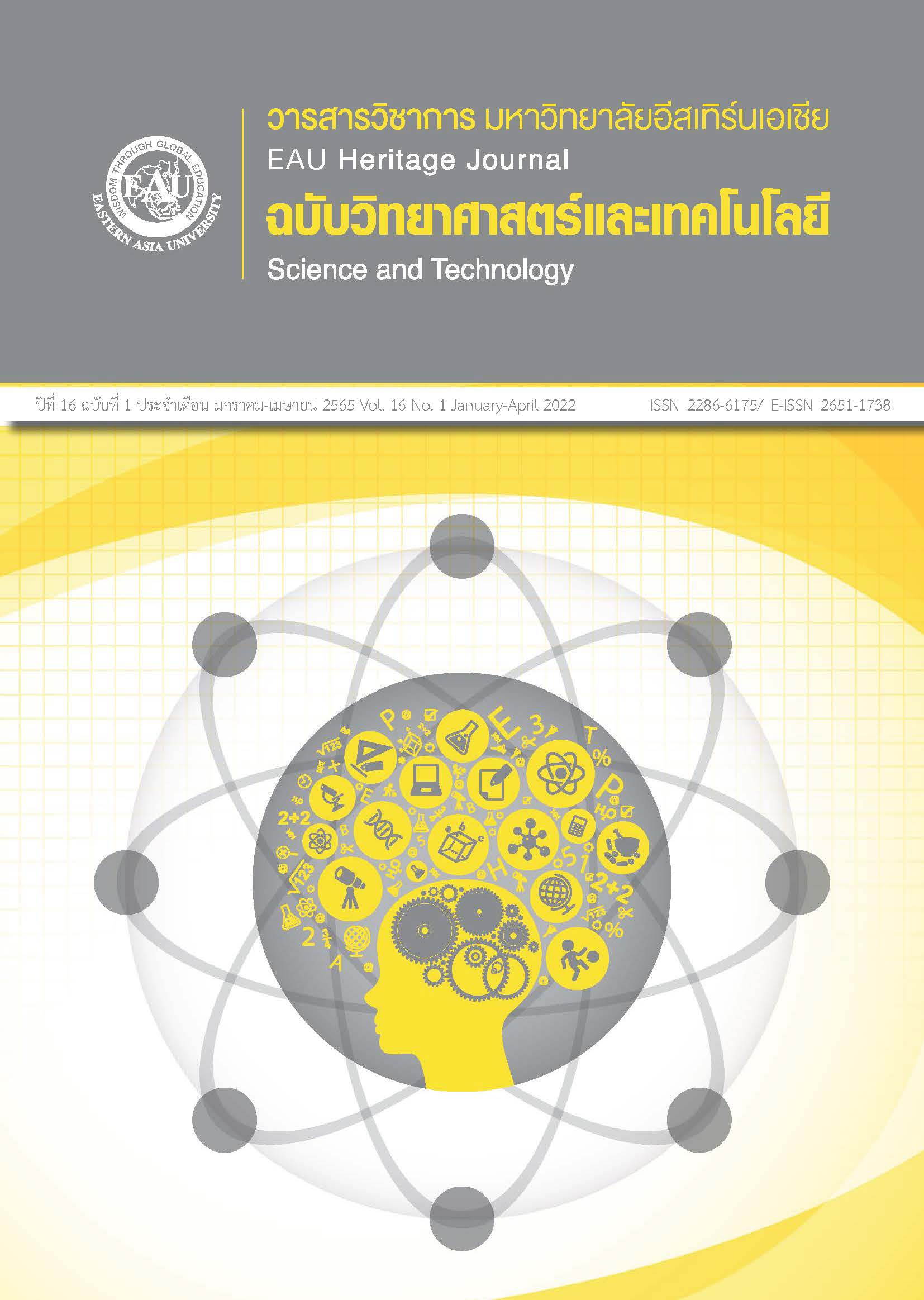ฤทธิ์ต้านแบคทีเรียของสารสกัดหยาบจากใบสาบเสือและใบบัวบกต่อ เชื้อสแตฟฟิโลคอคคัส ออเรียส
คำสำคัญ:
ฤทธิ์ต้านแบคทีเรีย, สาบเสือ, บัวบก, สารสกัดหยาบจากใบ สแตปฟิลโลคอคคัส ออเรียสบทคัดย่อ
สาบเสือ (Eupotorium odortum) และบัวบก (Centella asiatica) ถูกใช้รักษาโรคติดเชื้อในมนุษย์และสัตว์มายาวนาน โดยเฉพาะโรคติดเชื้อที่ผิวหนังและโรคในระบบทางเดินอาหารจากการได้รับสารพิษที่ S. aureus สร้างขึ้น สแตฟฟิโลคอคคัส ออเรียส (Staphylococcus aureus) เป็นแบคทีเรียแกรมบวก เป็นเชื้อสาเหตุในการติดเชื้อที่ผิวหนังและเนื้อเยื่อ นอกจากนี้ยังสามารถสร้างสารพิษซึ่งเป็นสาเหตุหลักในการก่อโรคอาหารเป็นพิษ วัตถุประสงค์ของการวิจัย เพื่อศึกษาเปรียบเทียบสารสกัดหยาบจากใบสาบเสือและใบบัวบกต่อการยับยั้งเชื้อ S. aureus TISTR 1466 โดยวิธีการแพร่ผ่านกระดาษ (paper disc diffusion) กานาไมซิน 30 ไมโครกรัม ถูกใช้เป็นตัวควบคุมเชิงบวก ส่วนน้ำกลั่นปราศจากเชื้อใช้เป็นตัวควบคุมเชิงลบ ค่าความเข้มข้นต่ำสุดที่สามารถยับยั้งการเจริญของเชื้อ (MIC) สแตปฟิลโลคอคคัส ออเรียส ของสารสกัดหยาบจากใบสาบเสือและใบบัวบก มีค่าเท่ากับ 6.25 มิลลิกรัมต่อมิลลิลิตร การประเมินค่าความเข้มข้นต่ำสุดที่สามารถฆ่าเชื้อ (MBC) สแตปฟิลโลคอคคัส ออเรียส ใช้เทคนิคการเกลี่ยเพลท (spread plate technique) บนจานอาหารเลี้ยงเชื้อแข็ง MSEY โดยสังเกตจากเชื้อที่ไม่สามารถเจริญได้บนอาหารเลี้ยงเชื้อแข็ง ค่า MBC ของสารสกัดจากใบสาบเสือและใบบัวบกที่ได้คือ 25.0 และ 12.5 มิลลิกรัมต่อมิลลิลิตร ตามลำดับ ดังนั้น พืชทั้งสองชนิดนี้มีศักยภาพสามารถใช้เป็นทางเลือกในการรักษาโรคติดเชื้อในมนุษย์และสัตว์ได้
เอกสารอ้างอิง
Arumugam, T., Ayyanar, M., Pillai, Y. J. K., & Sekar, T. (2011). Phytochemical screening and antibacterial activity of leaf and callus extracts of Centella asiatica. A Journal of the Bangladesh Pharmacological Society (BDPS), 6(1), 55-60. doi:10.3329/bjp.v6i1.8555
Dash, B. K., Faruquee, H. M., Biswas, S. K., Alam, M. K., Sisir, S. M., & Prodhan, U. K. (2011). Antibacterial and antifungal activities of several extracts of Centella asiatica L. against some human pathogenic microbes. Life Sciences and Medicine Research, 2011, 1-5. https://bit.ly/3tJgMqQ.
Hasnawati, H., & Prawita, E. (2010). Isolation and identification of antibacterial compound from Eupatorium odoratum L. leaves and its activity against Staphylococcus aureus ATCC 25923 and Escherichia coli ATCC 25922. Majalah Obat Tradisional, 15(1), 41–50. https://doi.org/10.22146/tradmedj.8067
Netala, V. R., Kotakadi, V. S., Nagam, V. Bobbu, P., Ghosh, S. B., & V. Tartte. (2015). First report of biomimetic synthesis of silver nanoparticles using aqueous callus extract of Centella asiatica and their antimicrobial activity. Applied Nanoscience, 5(7), 801-807. doi: 10.1007/s13204-014-0374-6
Nongnutch, K., & Nanuam, J. (2015). Alternative bio-pesticide for golden apple snail (Pomacea canaliculata). Suranaree Journal of Science and Technology, 23(1), 1-4. (in Thai)
Phaiboon, N., Pulbutr, P., Sungthong, B., & Rattanakiat. S. (2019). Effects of the Ethanolic Extracts of Guava Leaves, Licorice Roots and Cloves on the Cariogenic Properties of Streptococcus mutans. Pharmacognosy Journal, 11(5), 1029-1036. https://www.phcogj.com/sites/default/files/PJ-11-5-128.pdf
Prakash, V., Jaiwal, N., & Srivastava, M. (2017). A review on medicinal properties of Centella asiatica. Asian Journal of Pharmaceutical and Clinical Research, 10(10), 69-74. https://doi.org/10.22159/ajpcr.2017.v10i10.20760
Sintaweewarakul, C., Sintaweewarakul, W., & Harnthavee, M. (2009) The Use of the Eupatorium odoratum Linn. Leaves Crude Extract to Treat the Castration Wound in Piglet. Proceedings of 46th Kasetsart University Annual Conference: Animals and Veterinary Medicine (pp. 115-121), Bangkok: Kasetsart University. (in Thai).
Suwaibah, M., Zatilfarihiah, R., Aslizah, M. A., & Baharum, S. N. (2012). Chemical Composition of Local Eupatorium odoratum Essential Oil using GC-MS. UMT 11th International Annual Symposium on Sustainability Science and Management 09th-11th, July 2012 (pp. 1382-1388). Terengganu, Malaysia: Universiti Malaysia Terengganu.
Taemchuay, D., Rukkwamsuk, T., Sakpuaram, T., & Ruangwises, N. (2009). Antibacterial activity of crude extracts of Centella asiatica against Staphylococcus aureus in Bovine Mastitis. Kasetsart Veterinarians, 19(3), 119-128. (in Thai)
Wong, J. X., & Ramli, S. (2021). Antimicrobial activity of different types of Centella asiatica extracts against foodborne pathogens and food spoilage microorganisms. Food Science and Technology, 142(2), 1-6. doi:10.1016/j.lwt.2021.111026
Zahara, K., Bibi, Y., & Tabassum, S. (2014). Clinical and therapeutic benefits of Centella asiatica. Pure Applied Biology, 3(4), 152-159. doi:10.19045/bspab.2014.34004







